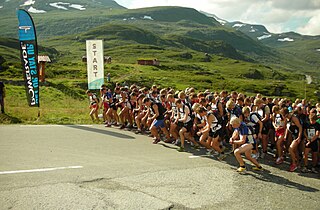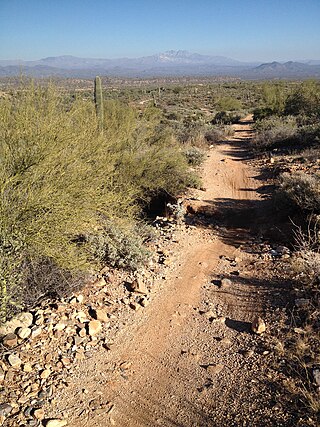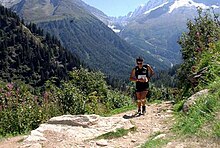
Long-distance running, or endurance running, is a form of continuous running over distances of at least 3 km (1.9 mi). Physiologically, it is largely aerobic in nature and requires stamina as well as mental strength.

Road running is the sport of running on a measured course over an established road. This differs from track and field on a regular track and cross country running over natural terrain.

An ultramarathon, also called ultra distance or ultra running, is a footrace longer than the traditional marathon length of 42.195 kilometres. Various distances, surfaces, and formats are raced competitively, from the shortest common ultramarathon of 31 miles (50 km) and up to 3100 miles. World Championships are held by the International Association of Ultrarunners (IAU) for 50 km, 100 km, 24 hours, and ultra trail running. The Global Organization of Multi-Day Ultramarathoners (GOMU) holds World Championships for 48 hours and 6 days. World Records are ratified and recognized by World Athletics, the IAU, and by GOMU.

Fell running, also sometimes known as hill running, is the sport of running and racing, off-road, over upland country where the gradient climbed is a significant component of the difficulty. The name arises from the origins of the English sport on the fells of northern Britain, especially those in the Lake District. It has elements of trail running, cross country and mountain running, but is also distinct from those disciplines.

Dean Karnazes, is an American ultramarathon runner, and author of Ultramarathon Man: Confessions of an All-Night Runner, which details ultra endurance running for the general public.

The International Association of Ultrarunners (IAU) is the world governing body of ultra running, race events longer than the marathon distance of 42.2 km. It regulates and sanctions the World Championships for various ultramarathon distances, and tracks world records in ultra distance races approved by IAU. IAU operates under the patronage of the World Athletics and follows World Athletics rules.
Multiday races are ultramarathon running events which are typically either segmented into daily events of a specified distance or time, or staged so that runners can run as far as they want, at their own discretion, over a set course or over a set number of days. Multiday races can range from continuous 48-hour track events to staged transcontinental treks.
Amy Palmiero-Winters is a below-knee amputee who currently holds eleven world records in various events. In 2010, she was awarded the James E. Sullivan Award as the top amateur athlete in the United States and the ESPN ESPY Award as the top female athlete with a disability in the world.
Hoka One One is a sportswear company that designs and markets running shoes. It was founded in 2009 in Annecy, France, and had been based in Richmond, California before it was acquired by Deckers Brands in 2013. Hoka first gained attention in the running industry by producing shoes with oversized midsoles, dubbed "maximalist" shoes, in contrast to the minimalist shoe trend that was gaining popularity at the time.

Ellie Greenwood is a British and Canadian ultramarathon runner. She is a four-time 100km World Champion, winning both individual and team titles in 2010 and 2014. She won the 90 km Comrades Marathon in South Africa in 2014, becoming the first British woman to win the race. Greenwood is also a former champion and course record holder for the Canadian Death Race, Western States 100, and the JFK 50 Mile Run.
Eleanor Robinson is a British former ultramarathon runner and two-time winner of the IAU 100km World Championships. She was the first woman to run over 150 miles in a 24-hour endurance race. She was the winner of the first Badwater Ultramarathon in 1987. She was twice bronze medallist at the IAU 100 km European Championships.

Lizzy Hawker is a British endurance athlete. She has been dubbed as the Queen of the mountains, running ultramarathons while climbing the heights of Mount Everest. Some of her career highlights include five wins at the Ultra-Trail du Mont-Blanc (UTMB), former World Record holder for 24 Hours, and winner of the 2006 IAU 100 km World Championships.
The definition of ultra-distance cycling is far more vague than in ultra running or in ultra-triathlon. Any bike race or ride longer than a century ride, which is 100 miles (160 km), is sometimes considered to be ultra-distance cycling. However, such events are relatively common, so using a longer distance to define the category is more useful, such as any race or ride that is longer than 200 kilometres (120 mi), 300 kilometres (190 mi) or even a double century, 200 miles (320 km).

Sage Clifton Read Canaday is an American long-distance runner and ultramarathoner.
Elisabet Barnes is a Swedish athlete specialized in ultrarunning. Her major claim to fame is winning the Marathon des Sables in 2015, winning each stage of the race. She repeated her win in 2017. The Marathon des Sables has been listed by Outside Magazine as one of the 9 toughest ultramarathons in the world. In 2015, she participated in six races, winning all and setting new course records in four.

Carol Morgan is an Irish ultrarunner, who specialises in non-stop mountain ultramarathons 100 km and longer, often in challenging conditions with significant ascents / descents. Born in Dublin in 1973, where she trained as a nurse, she is an advanced practitioner in emergency medicine. Morgan holds the course record for endurance ultra event, the Kerry Way Ultra.

Gary Cantrell, known as Lazarus Lake, is an endurance race designer and director. His races include the Barkley Marathons, Big's Backyard Ultra, the Barkley Fall Classic, Vol State 500K, A Race for the Ages, the Last Annual Heart of the South, and the Strolling Jim 40. In 2018, Lake covered the United States on foot, starting in Rhode Island and ending in Oregon.
Ekaterina Mityaeva is a Russian athlete specializing in trail running, skyrunning, mountain running and ultra running. She is a winner and prize-winner of the international competitions and Championships of Russia.
John Wade Kelly is an American endurance athlete who specializes in ultrarunning.

Javelina Jundred is a 100 mile (160 km) ultramarathon held at McDowell Mountain Regional Park in Fountain Hills, Arizona. Founded in 2002, it is one of the most popular ultramarathons in the United States, with over 850 runners as of 2023. The course also hosts shorter distances including a 100 kilometres (62 mi) and a 31 kilometres (19 mi) race. The race is named for the javelina.
















